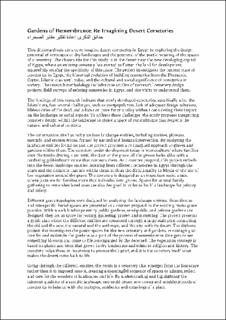| dc.description | This diploma thesis aims to re imagine desert cemeteries in Egypt by exploring the design potential of xeriscapes or dry landscapes and the potential of the poetic meaning of the spaces of a cemetery. The chosen site for this study is in the desert near the new developing capital of Egypt, where an existing cemetery has started to flatten the land for development, uncarefully erasing the specificity of this place. The project investigates the current state of cemeteries in Egypt, the historical evolution of building cemeteries from the Pharaonic, Coptic, Islamic eras until today, and the cultural and social significance of cemeteries in society. The research methodology includes case studies of successful cemetery design projects, field surveys of existing cemeteries in Egypt, and site visits to understand them.
The findings of this research indicate that newly developed cemeteries, specifically after the Islamic era, face several challenges, such as overpopulation, lack of adequate design solutions, lifeless cities of the dead, and a focus on pure functionality without considering their impact on the landscape or social aspects. To address these challenges, the study proposes integrating cemetery design within the landscape to create a space of remembrance that respects the natural and cultural contexts.
Different grave typologies were designed by analysing the landscape entities, these diverse and site-specific burial spaces are presented as a counter proposal to the existing mono grave practice. Within each landscape entity public gardens, semi-public, and private gardens are designed, they act as space for resting, gathering, prayer, and mourning. The project presents a guide plan where the different entities are connected through a large-scale plan connecting the old and the new, the natural and the anthropic, and the city with its desert. The diploma project also investigates the poetic spaces for the new cemetery and gardens, encouraging to care for and maintain the gardens as a part of the process of remembrance. One gets to see something blossom and come to life accompanied by the deceased. The vegetation strategy is based on plants and trees that grows in dry landscapes and relate to religion and history. The cemetery helps those in mourning to process their grief, and it is the cemetery itself what makes the desert come back to life.
By understanding and highlighting the inherent qualities of a specific landscape, one could create new towns and neighbourhoods of cemeteries in balance with the ecologies, aesthetics and meanings of a place. | en_US |



